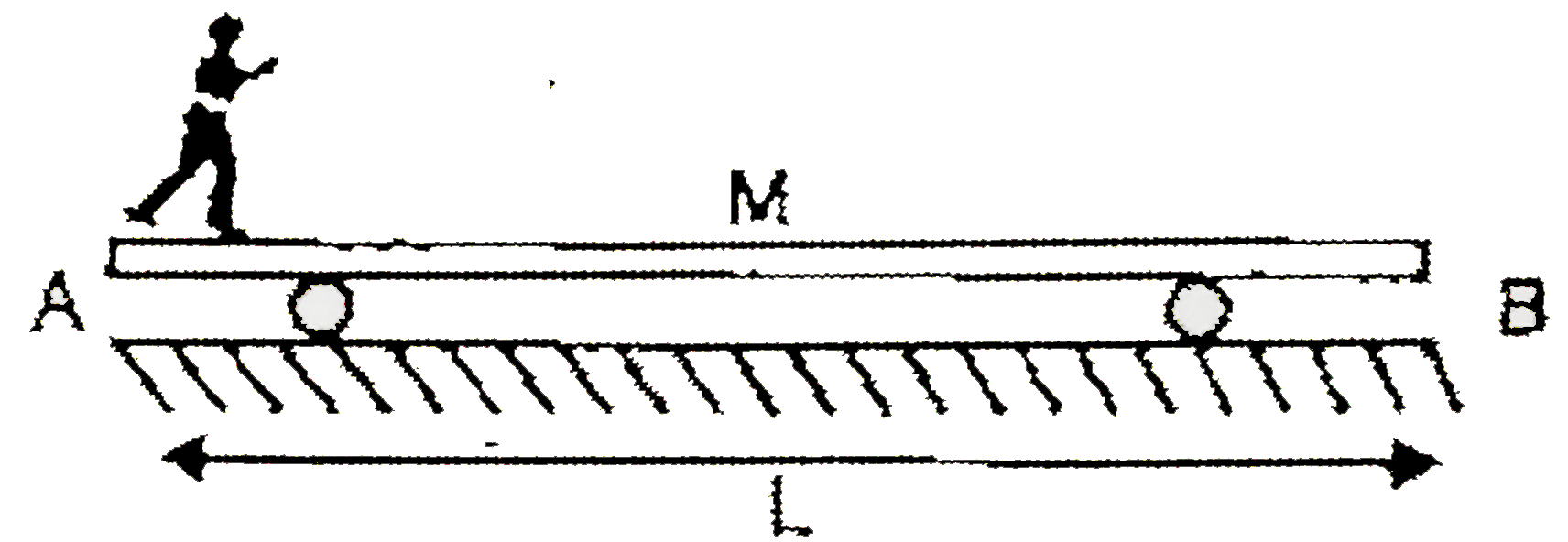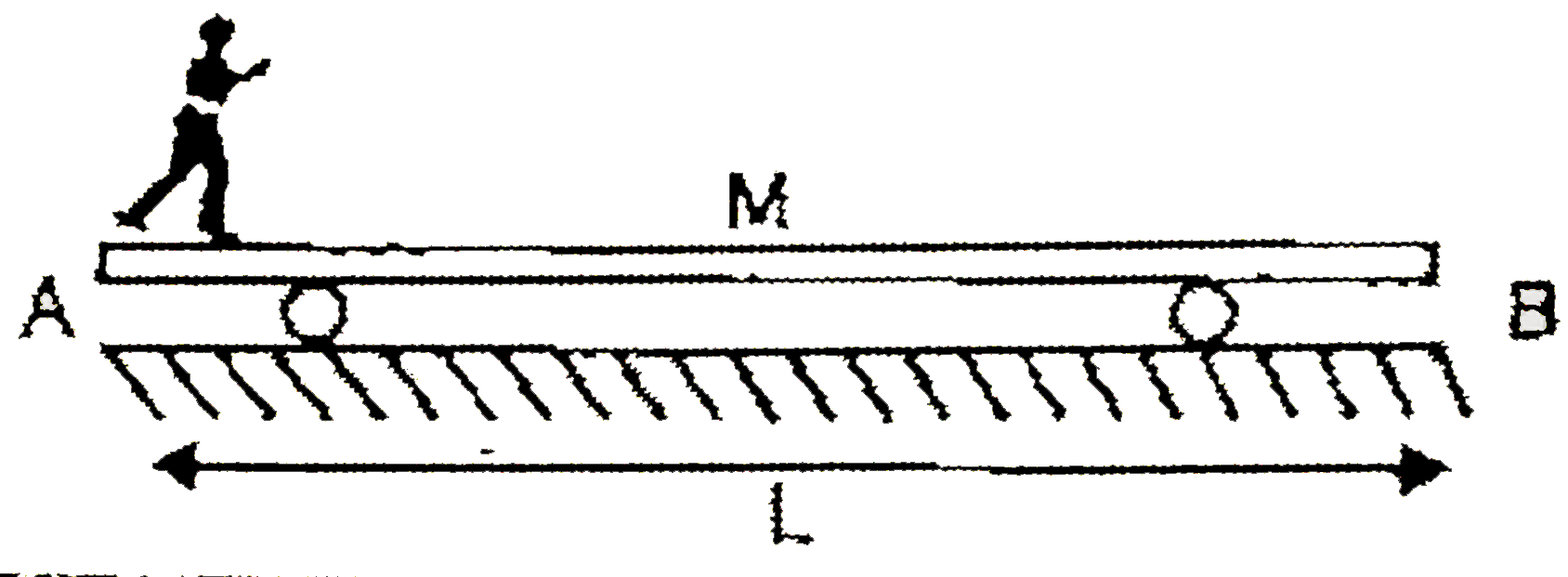A large trolley is kept at rest on a frictionless horizontal surface. There are same peple standing on the trolley. Initially no one is moving. is centre of mass of trolley and is centre of mass of trolley plus people. Now people start moving on the trolley.
Both will be displaced with respect to ground.
Both will remain at rest with respect to ground.
will move but will remain at rest with respect to ground
will move but will remain at rest with respect to ground
To solve the problem, we need to analyze the motion of the trolley and the people standing on it, considering the concepts of center of mass (COM) and the effects of internal and external forces.
1. Understanding the System:
- We have a large trolley on a frictionless horizontal surface with several people standing on it. Initially, both the trolley and the people are at rest.
2. Identifying Centers of Mass:
- Let C1 be the center of mass of the trolley alone.
- Let C2 be the center of mass of the trolley plus the people.
3. Initial State:
- Since the trolley is at rest and there are no external forces acting on the system (the trolley and the people), both C1 and C2 are at rest initially.
4. Movement of People:
- When the people start moving on the trolley, they exert forces on the trolley. However, since the surface is frictionless, the only forces acting are internal forces (the forces between the people and the trolley).
5. Effect on Center of Mass:
- The center of mass of the entire system (trolley + people) C2 will remain at rest because there are no external forces acting on the system as a whole.
- However, the center of mass of the trolley C1 will move because the people moving on the trolley create an internal force that causes the trolley to shift.
6. Conclusion:
- Therefore, C1 (the center of mass of the trolley) will move, while C2 (the center of mass of the trolley plus people) will remain at rest.
Final Answer:
- C1 will move, and C2 will not move.
- We have a large trolley on a frictionless horizontal surface with several people standing on it. Initially, both the trolley and the people are at rest.
- Let C1 be the center of mass of the trolley alone.
- Let C2 be the center of mass of the trolley plus the people.
- Since the trolley is at rest and there are no external forces acting on the system (the trolley and the people), both C1 and C2 are at rest initially.
- When the people start moving on the trolley, they exert forces on the trolley. However, since the surface is frictionless, the only forces acting are internal forces (the forces between the people and the trolley).
- The center of mass of the entire system (trolley + people) C2 will remain at rest because there are no external forces acting on the system as a whole.
- However, the center of mass of the trolley C1 will move because the people moving on the trolley create an internal force that causes the trolley to shift.
- Therefore, C1 (the center of mass of the trolley) will move, while C2 (the center of mass of the trolley plus people) will remain at rest.
- C1 will move, and C2 will not move.
Topper's Solved these Questions
- SYSTEMS OF PARTICLES AND ROTATIONAL MOTIONBOOK - MODERN PUBLICATIONCHAPTER - SYSTEMS OF PARTICLES AND ROTATIONAL MOTIONEXERCISE - COMPETITION FILE ( OBJECTIVE TYPE QUESTIONS (JEE (Main) & Other State Boards for Engineering Entrance) )
48 Videos
- SYSTEMS OF PARTICLES AND ROTATIONAL MOTIONBOOK - MODERN PUBLICATIONCHAPTER - SYSTEMS OF PARTICLES AND ROTATIONAL MOTIONEXERCISE - COMPETITION FILE ( OBJECTIVE TYPE QUESTIONS MULTIPLE CHOICE QUESTIONS (with more than one correct answer) )
35 Videos
- SYSTEMS OF PARTICLES AND ROTATIONAL MOTIONBOOK - MODERN PUBLICATIONCHAPTER - SYSTEMS OF PARTICLES AND ROTATIONAL MOTIONEXERCISE - REVISION EXERCISES (Numerical Problems)
20 Videos
- PHYSICAL WORLD BOOK - MODERN PUBLICATIONCHAPTER - PHYSICAL WORLD EXERCISE - Revision exercises (Long answer questions)
6 Videos
- THERMAL PROPERTIES OF MATTERBOOK - MODERN PUBLICATIONCHAPTER - THERMAL PROPERTIES OF MATTEREXERCISE - CHAPTER PRACTICE TEST
15 Videos
Similar Questions
The figure shows a man of mass m standing at the end A of a trolley of maas M placed at rest on a smooth horizontal surface. The man starts moving towards the end B with a velocity urel with respect to the trolley. The length of the trolley is L.

As the man walks on the trolley, the centre of mass of the system (man+ trolley) :
View SolutionThe figure shows a man of mass m standing at the end A of a trolley of maas M placed at rest on a smooth horizontal surface. The man starts moving towards the end B with a velocity urel with respect to the trolley. The length of the trolley is L.

When the man starts moving, then the velocity of the trolley v2 with respect to ground will be:
View Solution
Knowledge Check
A man weighing 80kg is standing on a trolley weighing 320kg. The trolley is resting on frictionless horizontal rails. If the man starts walking on the trolley along the rails at speed 1m/s (w.r.t. to trolley) then after 4s his displacement relative to the ground will be :
A5 mB4.8 mC3.2 mD3.0 m
The figure shows a man of mass m standing at the end A of a trolley of maas M placed at rest on a smooth horizontal surface. The man starts moving towards the end B with a velocity urel with respect to the trolley. The length of the trolley is L.

The time taken by the man to reach the other end is:
View SolutionThe figure shows a man of mass m standing at the end A of a trolley of maas M placed at rest on a smooth horizontal surface. The man starts moving towards the end B with a velocity urel with respect to the trolley. The length of the trolley is L.

When the man reaches the end B, the distance moves . by the trolley with respect to ground is:
View SolutionA man standing on a trolley pushes another identical a trolley (both trolleys are at rest on a rough surface), are set in motion and stop alter some time so that they If the ratio of mass of first trolley with man to mass of second trolley is 3, then find the ratio of the stopping distances of the second trolley to that of the first trolley. (Assume coefficient of friction to be the same for both the trolleys)
View SolutionThe figure shows a man of mass m standing at the end A of a trolley of maas M placed at rest on a smooth horizontal surface. The man starts moving towards the end B with a velocity urel with respect to the trolley. The length of the trolley is L.

The velocity of the man with respect to ground v1 will be:
View SolutionThis figure shows a man of mass m standing at the end A to a trolley of mass M placed at rest on a smooth horizontal surface. The man starts moving towards the end B with a velocity urel with respect to the trolley. The length of the trolley is L.

(a) Find the time taken by the man to reach the other end.
(b) As the man walk on the trolley, find the velocity centre of mass of the system (man+trolley).
(c) When the man reaches the end B, find the distance moves by the trolley with respect to ground.
(d) Find the distance moved by the man with respect to ground.
View SolutionA trolley of initial mass m0 is kept over a smooth surface as shown in figure. A constant force F is applied on it. Sand kept inside the trolley drains out from its floor at a constant rate of (μ)kg/s. After time t find:

(a) total mass of trolley and sand.
(b) net force on the trolley.
(c) velocity of trolley.
View SolutionA (trolley + child) of total mass 200 kg is moving with a uniform speed of 36 km/h on a frictionless track. The child of mass 20 kg starts running on the trolley from one end to the other (10 m away) with a speed of 10 ms–1 relative to the trolley in the direction of the trolley's motion and jumps out of the trolley with the same relative velocity. What is the final speed of the trolley? How much has the trolley moved from the time the child begins to run?
View Solution
